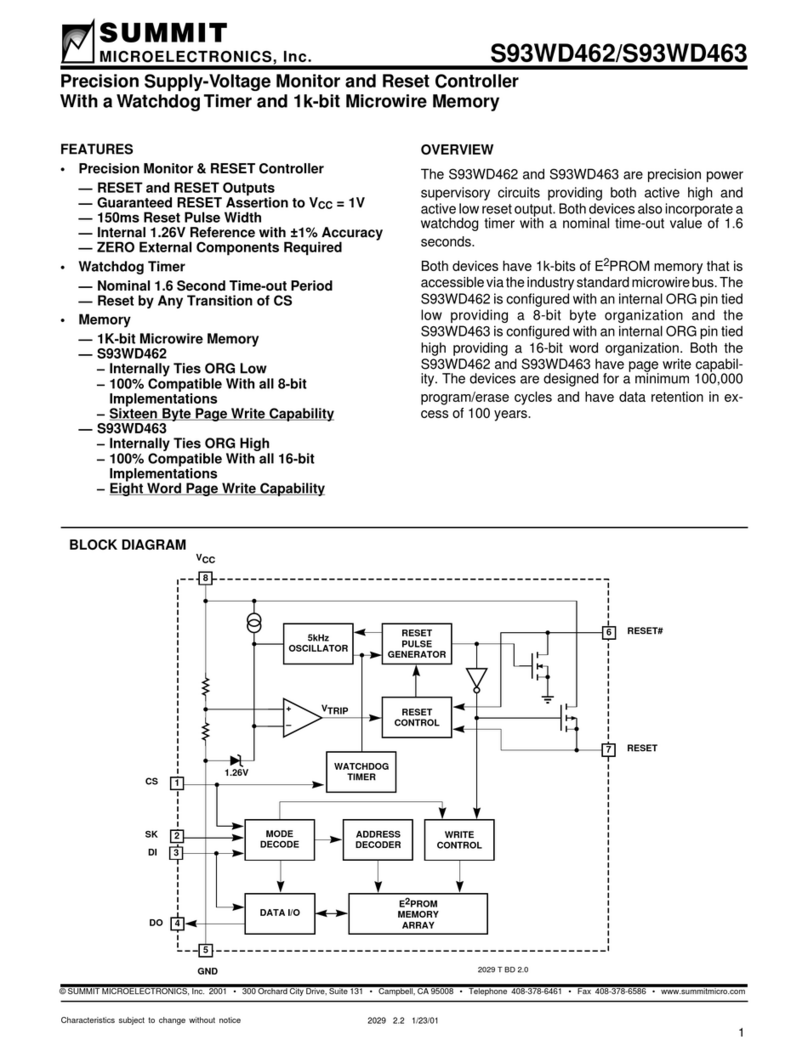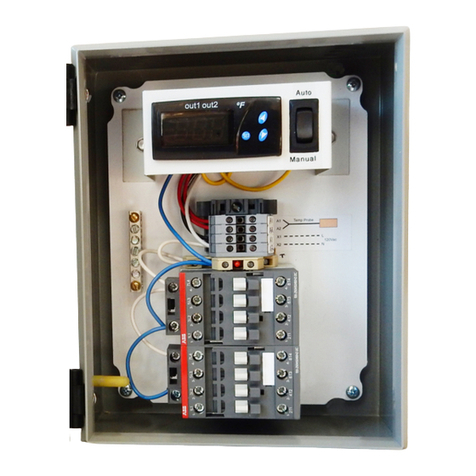
SMH4804 Functional Description
Summit Microelectronics 2050 3.8 10/13/05 3
–\
FUNCTIONAL DESCRIPTION
The SMH4804 integrated hot swap power controller
operates within a wide supply range, typically -32 to -72
volts, and generates the signals necessary to drive isolated-
output DC/DC converters. The general start-up procedure is
as follows:
• A physical connection must first be made with the
chassis to discharge any electrostatic voltage potentials
when a typical add-in board is inserted into the powered
backplane.
• The board then contacts the long pins on the backplane
that provide power and ground.
• As soon as power is applied the device starts up, but
does not immediately apply power to the output load.
• Under-voltage and over-voltage circuits inside the
controller verify that the input voltage is within a user-
specified range.
• The SMH4804 senses the PD1# and PD2# pin
detection signals to indicate the card is seated properly.
These requirements must be met for a Pin Detect Delay
period of tPDD. Once this time has elapsed, the hot-swap
controller enables VGATE to turn on the external power
MOSFET switch. The VGATE output is current limited to
IVGATE, allowing the slew rate to be easily modified using
external passive components. During the controlled turn-on
period the VDS of the MOSFET is monitored by the drain
sense input. When DRAIN SENSE drops below 2.5V, and
VGATE rises above VDD – VGT, the SMH4804 asserts the
PG1# through PG4# power good outputs to enable the DC/
DC controllers. The ENPGA, ENPGB, and ENPGC Power
Good Enable inputs may be used to activate or deactivate
specific output loads.
Steady-state operation is maintained as long as all
conditions are normal. Any of the following events may
cause the device to disable the DC/DC controllers by
shutting down the power MOSFET:
• an under-voltage or over-voltage condition on the host
power supply.
• an over-current event detected on the CBSENSE input
• a failure of the power MOSFET sensed via the DRAIN
SENSE pin.
• the PD1#/PD2# pin detect signals becoming invalid.
• the master enable (EN/TS) falls below 2.5V.
• the FS# input is driven low by events on the secondary
side of the DC/DC controllers.
The SMH4804 may be configured so that after any of these
events occurs, the VGATE output shuts off and either
latches into an off state, or recycles power after a cooling
down period, tCYC.
Powering VDD
The SMH4804 contains an internal shunt regulator on the
VDD pin that prevents the voltage from exceeding 12V. It is
necessary to use a dropper resistor (RD) between the host
power supply and the VDD pin in order to limit current into the
device and prevent possible damage. The dropper resistor
allows the device to operate across a wide range of system
supply voltages, typically -32 V to -72V, and also helps
protect the device against common-mode power surges.
Refer to the Applications Section for help on calculating the
RDresistance value.
Hot-Swap Verification
There are several enabling inputs that allow the host to
control the SMH4804. The Pin Detect signals (PD1# and
PD2#) are two active low enables that are generally used to
indicate that the add-in circuit card is properly seated.
These inputs must be held low for a pin-detect delay period
of tPDD before a power-up sequence may be initiated. This is
typically done by clamping the inputs to VSS through the
implementation of an ejector switch, or alternatively through
the use of staggered pins at the card-cage interface. The pin
detect delay (tPDD) timing parameter is controlled by bits 1:0
of register 9. Refer to Register 9 - Address 1001 on page 38
for more information.
Two shorter pins, arranged at opposite ends of the
connector, force the card to be fully seated before both pin
detects are enabled. Care must be taken not to exceed the
maximum voltage rating of these pins during the insertion
process. Refer to details in the Applications Section for
proper circuit implementation. Note that the PD1# and PD2#
inputs are enabled or disabled using bit 0 of Register 3.
Refer to Register 3 - Address 0011 on page 32 for more
information.
The EN/TS input provides an active high comparator input
that may be used as a master enable or temperature sense
input. This input signal must exceed 2.5V (nominal) for
proper operation. Refer to the Pin Descriptions on page 10
for more information.
Under-/Over-Voltage Sensing
The Under-Voltage (UV) and Over-Voltage (OV) inputs
provide a set of comparators that act in conjunction with an
external resistive divider ladder to sense whether or not the
host supply voltage is within the user-defined limits. The
power-up sequence is initiated when the input to the UV pin
rises above 2.5V and the input to the OV pin falls below






























